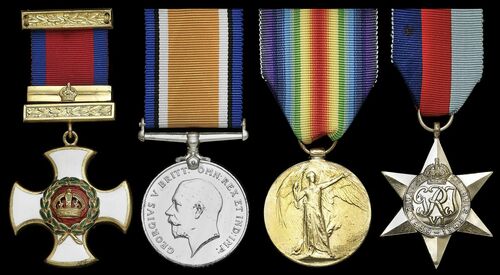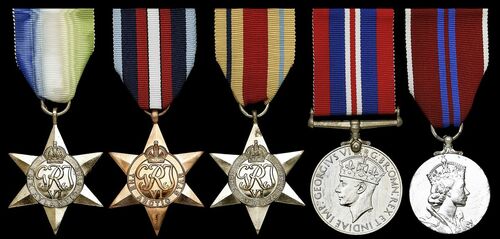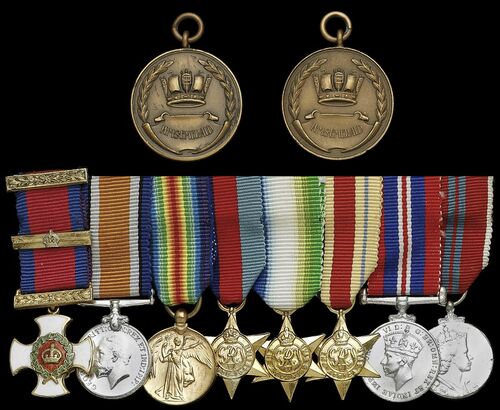Auction: 23003 - Orders, Decorations and Medals
Lot: 230
The superb 'Dunkirk' 1940 D.S.O. and 'Operation Hotbed' 1945 Second Award Bar group of nine awarded to Captain V. N. Surtees, Royal Navy, who, after an action-packed war, was additionally recommended for a Decoration for exceptional service during the devastating 1953 North Sea flood whilst Captain-in-Charge of Sheerness Dockyard
Distinguished Service Order, G.VI.R., silver-gilt and enamel, top-bar suspension adapted for wear, reverse officially dated '1940', with Second Award Bar, reverse officially dated '1945'; British War and Victory Medals (Mid. V. N. Surtees); 1939-1945 Star; Atlantic Star; Arctic Star; Africa Star; War Medal 1939-45; Coronation 1953, all except first and sixth sometime lacquered, some minor scratches to edge of first, otherwise good very fine (9)
D.S.O. London Gazette 7 June 1940:
'The King has been graciously pleased to give orders for the following reward for good services in the withdrawal of the Allied Armies from the beaches at Dunkirk.'
The Recommendation shared with Commander's Maund, Clouston & Gotto states:
'For distinguished service, under arduous conditions, while serving on the piers or beaches at Dunkirk, and assisting in the embarkation of the Allied Armies. The pier and beach parties were subjected to continual bombing attacks and were frequently under shell fire.'
Second Award Bar to the D.S.O. London Gazette 19 June 1945:
'For outstanding courage, determination, and skill while serving in H.M. Ships Nairana, Campania, Lark, Alnwick Castle, Onslow, Onslaught, Cygnet, Whitehall, Orwell, Zambesi, Zealous, Zest and Opportune, and H.M.C.S. Sioux, in escorting a convoy to and from North Russia under continuous and fierce attacks by the enemy and in exceptionally hard weather conditions'.
The Recommendation states:
'H.M. Ships were engaged in the protection of a convoy to North Russia and of a return convoy in February 1945. Heavy attacks by aircraft were met with, and by U-Boats which were concentrated outside Kola. Two escort vessels and one merchant ship in the return convoy were sunk by U-Boat, and one merchant ship which had lost the convoy through the heavy weather was sunk by aircraft. Heavy toll was taken of the attacking aircraft and one U-boat was sunk by H.M.S. Lark and Alnwick Castle. Heavy gales persisted throughout which greatly increased the heazrds of operating carrier-borne aircraft.'
Further Recommendation from Admiral Henry Moore:
'The responsibilities and anxieties resting upon the commanding officers of these escort carriers are particularly onerous and I wish particularly to invite the attention of Their Lordships to the recommendations for the award of decorations to Captain V.N. Surtees D.S.O., H.M.S. Nairana, and Acting Captain K.A. Short, H.M.S. Campania. Both these ships have done consistently well while under the command of these officers, not only in several North Russian convoys, but also inother offensive operations off the Norwegian coast. Captain Surtees and Short have both recently been relieved and I recommend most strongly that their outstanding services in the Home Fleet should now be rewarded.'
Further Recommendation from Rear-Admiral Younger:
'H.M.S. Nairana has taken part in three North Russian Convoys in company with me and has obtained very successful results both in A.attacks with her Swordfish and in breaking up Ju88 torpedo aircraft formations and shooting down aircraft with her fighters. Captain Surtees has inspired his Squadron and they have operated with great success in conditions which often seemed quite impossible, so contributing to a very great extent to the safety of these Convoys. As an example, the reckless gallantry and skill of his fighter pilots successfully operating during the Ju88 torpedo attacks on J.W.64/R.A.64 on 10th and 20th February 1945 in extremely bad weather conditions was only matched by the skill with which "Nairana" recovered these aircraft on their return. I consider that the highest credit is due to the leadership and inspiration of Captain Surtees and I strongly recommend him for a decoration.
Recommendation for Award - which was somehow never promulgated - in Connection with East Coast Floods of 1953:
'Captain Surtees, as Captain-in-Charge of Sheerness Dockyard, was called in the early hours of the morning of Sunday, 1st February, and informed that the tide was coming over the dock wall. He at once went into the Dockyard and directed the efforts to minimise the damage. In pitch darkness, and in water over four feet deep, he continued to control the work at considerable risk of being swept away by the flood. He had to be hauled up to the roof of a building at one stage, but in spite of exposure and exhaustion he remained on duty continuously for over 36 hours without rest.
For the next sixteen days he worked unceasingly to restore the Dockyard to working order, and it was largely due to him that the chaos caused by the flood was overcome so quickly.'
Villiers Nicholas Surtees was born in Fulham, London, on 5 June 1899 and entered service with the Royal Navy on 7 September 1917, being appointed Midshipman aboard the Lion-class Battlecruiser H.M.S. Princess Royal from February 1918 through to May 1919 when he removed to H.M.S. Lion and from thence on to the infamous H.M.S. Hood. The 'Remarks' column in his personal file contains a significant number of positive comments from senior officers including: 'An officer whom I am expecting to do well' - a most astute evaluation of things to come. Surtees rose steadily through the ranks in the post-war Royal Navy with the usual appointments both at home and abroad, being promoted Sub-Lieutenant in July 1919; Lieutenant on 15 August 1921; Lieutenant-Commander in August 1929; and Commander on 30 June 1936 - the rank in which he entered the fray upon the declaration of war three years later.
Dunkirk and First Honours
By 1940 Commander Surtees was a member of British Naval Headquarters at Dover and when, on 26 May, Captain William "Dunkirk Joe" Tennant was appointed Senior Naval Officer ashore to superintend the evacuation he took a mere eight officers and 160 men with him to complete the task - Surtees was one of those eight in the former category, and together they sailed across the English Channel to France on the destroyer H.M.S. Wolfhound. As can be expected, each officer of Tennant's party was given a specific task to perform; Surtees was a member of British Naval Headquarters which was initially stationed in Bastion 32 before moving to Bastion 28, close to the famous mole. He was made Captain on 30 June 1943. Post-war he was admitted to Chatham and Plymouth hospitals for a vaiety of medical conditions. He was placed on the Retired List on 8 July 1952 but was re-appointed shortly after. He was found unfit for further Naval Service as a result of Cirrhosis of the liver on 11 November 1953 and reverted to the Retired List as being Medically Unfit on 3 Febuary 1954. Surtees died on 12 April 1954.
Subject to 20% VAT on Buyer’s Premium. For more information please view Terms and Conditions for Buyers.
Sold for
£5,200
Starting price
£2500









